News Releases
The 8th Annual Bioblitz Goes to Tabaquite
By Stephanie Warren-Gittens
Bioblitz? What exactly is that you may ask? Well, Bioblitz is a highly anticipated annual event for local naturalists, as it is an intense survey done in a 24-hour period to find as many species as possible within a given area!
Started in 2012, this event has been held in various parts of Trinidad and Tobago from Tucker Valley to Icacos even to Charlotteville, where a whopping 1044 species were found in the latter location alone! This year, Bioblitz 2019 will take place in Tabaquite on Saturday 2nd and Sunday 3rd November. The centre of the weekend’s activities or basecamp will be located at the Tabaquite Secondary School.
From noon Saturday to noon Sunday, scientists, naturalists and volunteers will walk trails within the Tabaquite area looking for plants, mammals, insects, birds, fish, fungi, reptiles, lizards, even down to microbes- just about any living organism.
Camera traps have already been strategically placed in the area, to record any mammals, which may not present themselves on the weekend of Bioblitz.
Participants are also encouraged to use the iNaturalist app to log their findings, which is also a great day-to-day app which can be used to identify organisms.
On the Sunday (3rd November) from 7 am-2 pm, the public is invited to visit the basecamp to view displays from several environmental groups, see what organisms have been found, walk the trails and interact with the Bioblitz team. This is a great opportunity to gain exposure for those (children included) who may be curious about the natural environment and not too sure how to get into the field and make a contribution to science.
At the end of the event, all species found from the different groups will be tabulated to get the preliminary species count for the area and announced at 1 pm. These results, as well as that of past Bioblitzes are useful as important ecological baseline data for future surveys.
Bioblitz is brought to you by the Trinidad and Tobago Field Naturalists’ Club, with assistance from the Department of Life Sciences and UWI Zoology Museum at the University of the West Indies. Follow our Facebook Page T&T Bioblitz to keep updated!
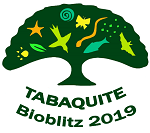
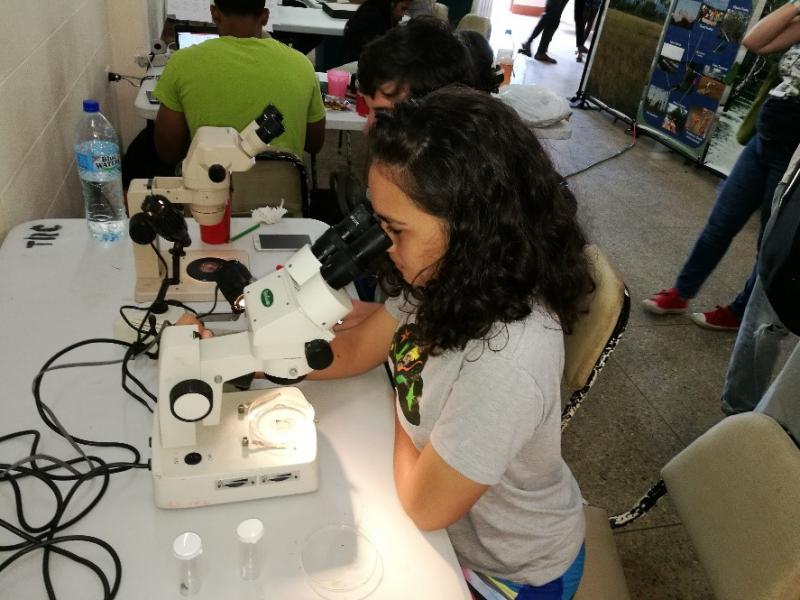
A Bioblitzer observing an organism under a microscope at Basecamp_ Photo by S. Warren-Gittens
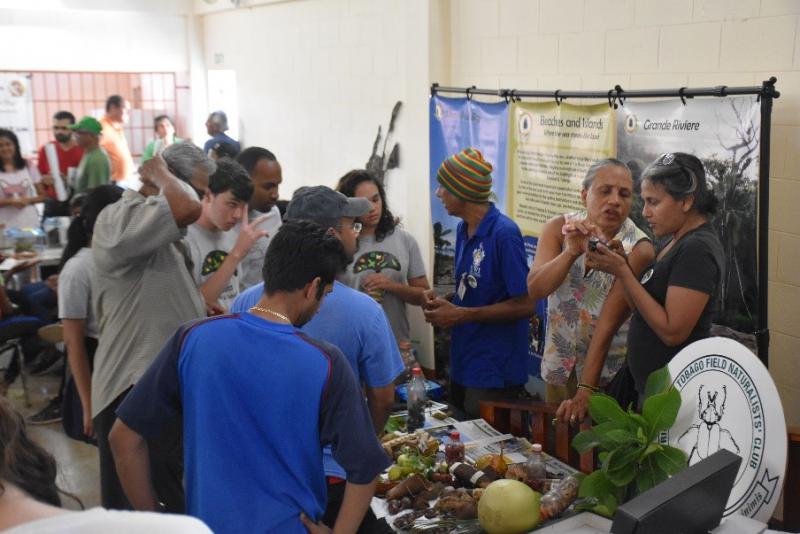
Sunday activities at Basecamp _Photo by A. Farrell
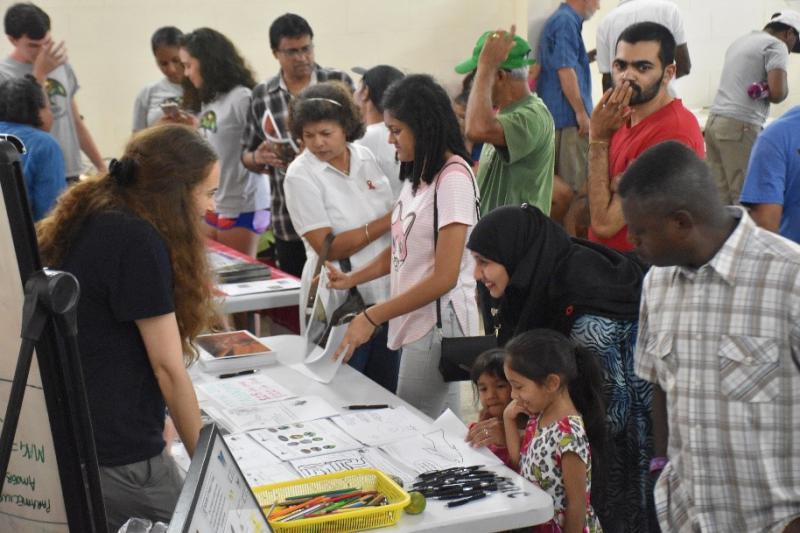
Sunday activities at Basecamp _Photo by A. Farrell
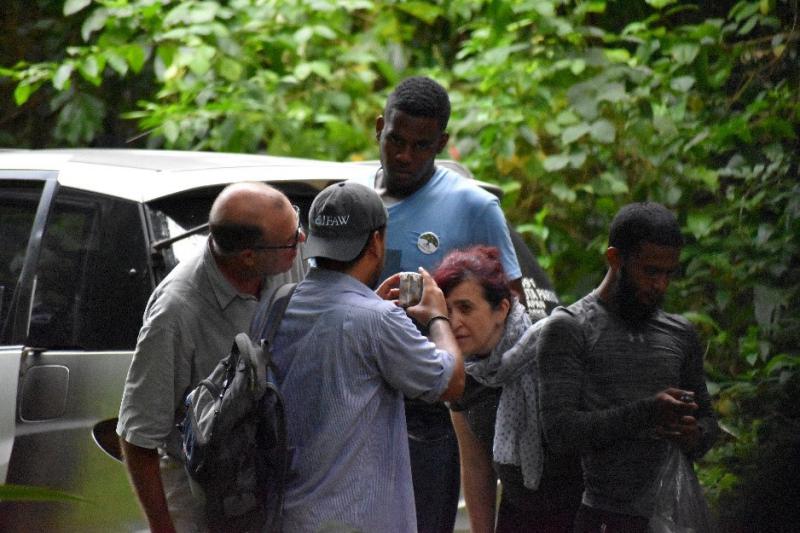
Bioblitzers in the field observing a specimen for ID_ Photo by N. Bridglal
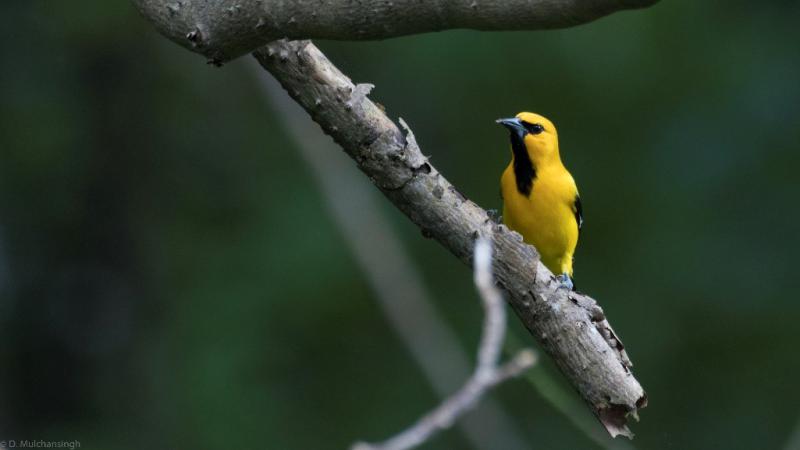
Yellow Oriole spotted at last year’s Bioblitz_ Photo by D. Mulchansingh

A Bioblitzer gets down to get a shot of a bird in the distance at last year’s Bioblitz_ Photo by E. Seebaran.
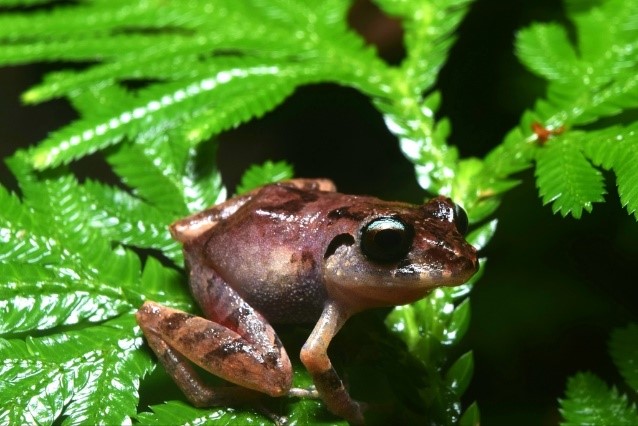
A frog spotted at last year’s Bioblitz_ Photo by R. Deo
Posted on: October 29th 2019
By Jarome Ali and Amy Deacon
In 2017 The Department of Life Sciences launched a new initiative called the ‘Life in Science Sessions’. These sessions are aimed at creating a space where researchers can share their work in a friendly, comfortable atmosphere, in a less formal setting than the Thursday seminar series.

A female guppy - the theme of Dr Amy Deacon's 'Life in Science'.
Initially instigated by Jarome Ali, an Associate Professional, and his supervisor Dr Amy Deacon, the sessions are now co-organised by two postgraduates: Delezia Singh and Joshua Spiers.
The idea behind the monthly sessions is that scientific research can be all-consuming, and researchers may become so swamped in their work that they don’t have to opportunity to share it with their colleagues or to find out about the work of others.
To remedy this, Life in Science sessions feature a short, informal talk (about 20 minutes) detailing the biography, past research or ongoing work of a member of staff or postgraduate student from the department. This is followed by a social where people can chat about the topic of the day, share their ideas and catch-up over drinks and snacks. That is, the events are a chance to share about Life Science or one’s ‘Life in Science’. While discussing this event, the Head of Department noted that, before his passing, Professor Chadee was also considering starting a series with the same goals.

Full house: Just part of the crowd at the first Life in Science Session
Our first event was held on the 17th of May and Dr Deacon discussed her fascination with the Trinidadian guppy as a system for research. She described how she carries out behavioural and mesocosm experiments to investigate why guppies are so good at invading new environments. One of the standout discoveries she mentioned was that just a single female guppy is capable of establishing a population that can survive for at least 2 years! The answer to the obvious question is that female guppies are able to store sperm once they’ve mated, and then later choose when to fertilise their eggs.
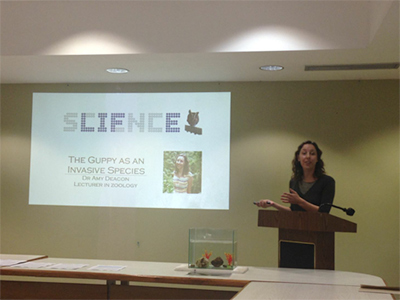
Dr Deacon gives the feature talk for the first Life in Science Session
The sessions have now been running for 6 months, and are extremely well attended by both staff and students, creating a culture of collaboration within the department that would make Professor Chadee proud.
The last session for 2017 will be from Dr Alexis Marianes on Wednesday 13th December at 4 pm, Natural Sciences Conference Room. The talk is entitled ‘A Pleasure in the Pathless Woods’. All are welcome to join us for science, snacks and socialising!
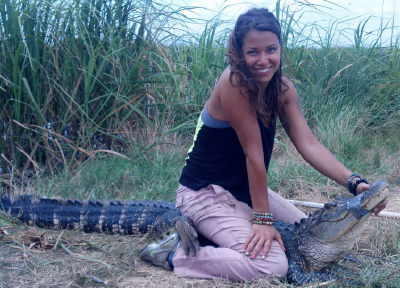
We will learn more about Dr Alexis Marianes’ ‘Life in Science’ at December’s session!
Look out for Ryan Mohammed and Richard Sebro in 'Life in Science' at February's session!
By Mike G. Rutherford
Before dawn on Saturday 4th, November cars loaded with enthusiastic nature lovers made their way to the furthest south-west point of Trinidad. Their aim? To join in the 6th T&T Bioblitz in the beautiful Icacos peninsula. Their initial destination was the Icacos Government Primary School, the basecamp for the weekend. The Bioblitzers, made up of members of the Trinidad & Tobago Field Naturalists’ Club, staff and students from The University of the West Indies and many others, set up tents, hung hammocks and prepared equipment in preparation for what would be a long but fun weekend. The main hall was turned into a biodiversity display and identification zone with microscopes, books and laptops, and tables covered in specimens.
The briefing for the surveying teams, by Mike Rutherford, the curator of the University of the West Indies Zoology Museum (UWIZM), began just after 11 am. At noon, participants headed off in different directions to start the 24 hours of searching which would last until noon on Sunday 5th.

Bioblitzers on Soldado Rock. Photo by Mike Rutherford
The main area for surveying was a 10km wide circle which stretched from the beach at Icacos to the St. Marie Road just south of Bonasse village. Most of the participants explored four trails during their surveying; Trail 1 took them from the centre of Icacos village to the coast along an old road passing through secondary forest and coconut plantation; Trail 2 started at the Columbus Bay parking area and looped around the headland through some mangrove forest; Trail 3 headed through the cocal plantations to the Icacos mud volcanoes and Trail 4 took the teams along St. Marie Road into some good secondary forest. However, one team ventured outside the circle to visit Soldado Rock, a wildlife reserve about 10km west of Icacos between Trinidad and Venezuela.
The Soldado group took a fishing boat from the Icacos beach and headed to the tiny island. Pelicans and magnificent frigatebirds covered the rocks, with many of the male frigates inflating their bright red throat pouches to display to the females. The team of nine landed on the island and whilst representatives of the plant, bird, reptile and invertebrate groups scoured the land, three members of the aquatic team snorkelled in the small cove to see what underwater life they could find. Interesting finds included a large iguana, a dead giant centipede, two green turtles and even a hummingbird making a quick stop on the way from Venezuela to Trinidad.

Male magnificent frigatebird displaying. Photo by Peter Dickson
Back on the mainland, part of the birding group, led by TTFNC president Darshan Narang, set themselves up along an old trail to the east of Icacos. Instead of walking around searching with binoculars, they let the birds come to them; mist nets placed across a clearing in the forest allowed them to catch small birds, which were identified, had a band placed on their leg and then released. The rest of the birders covered the other trails and observed many species including the uncommon crested caracara, grey-cowled wood-rail, pinnated bittern and spotted tody-flycatcher.
Members of the mammal group, led by Laura Baboolal, continued using the mist nets that night to catch bats, catching an impressive 50 individuals from seven species. Other mammal sightings included a couple of capuchin monkeys in the forest, most likely these were escaped pets, possibly brought over from Venezuela.
Mixed teams of plant and animal experts followed TTFNC guide Dan Jaggernauth through the cocal plantations to a patch of forest which surrounds the Icacos mud volcanoes. The mammal team had some trail cameras to retrieve from this site and a few more from the forest near Bonasse, analysis of the photos revealed the presence of agouti and manicou.
The plant group, led by Mike Oatham and joined by members of the Forestry Division, visited all the trails and as well as identifying many plants where they found them they also gathered leaves, flowers and seeds to take back to basecamp for more accurate identification with the help of expert Winston Johnson and a plethora of books and scientific papers. Members of the National Herbarium of T&T, led by Shane Ballah, focused on mosses and lichens.
The reptile and amphibian team, led by Saiyaad Ali of the Serpentarium and Renoir Auguste from UWI, did some surveying in the day but their main period of activity was through the night. The Icacos area is well known amongst herpetologists for the variety of frogs to be found there and this weekend it did not disappoint. Seventeen different species were found in the swamps, rivers, ditches and pools, more than any previous Bioblitz.

Small-headed Treefrog. Photo by Renoir Auguste
The teams also found many species of snakes and lizards and not surprisingly there were caiman all over the place. The Serpentarium crew brought many of the animals they found to the basecamp on the Sunday to temporarily display them for the public.
Several small groups looked for insects, spiders, scorpions and other terrestrial invertebrates. Jo-Anne Sewlal spent Saturday afternoon finding spiders in the forests whilst Rakesh Bhukal and his team looked for dragonflies in the swamps in the day and scorpions at night. Lauren Ali did a great job of pulling together all the butterfly sightings.
Whilst most teams spent their time in the forests, the aquatic team, led by Ryan Mohammed from UWI, focused on the beaches and swampy areas. Using a variety of nets and traps they collected a wide range of fish, crustaceans and molluscs. Highlights included a night-time survey of Columbus Bay at low tide under the full moon when many species of marine snails and worms could be found crawling across the muddy beach.
The Microbe team had been cultivating bacterial and fungal samples in their laboratory over the previous weeks from local water and soil samples collected before the Bioblitz. Members of the team came down to put on a display as part of the educational outreach at the school. With a mix of games and activities, they taught the public all about these microscopic forms of life.

Displays and visitors at the basecamp. Photo by Mike Rutherford
Fungus enthusiast, Jeffrey Wong Sang, came down on Sunday morning. After heading out on a couple of the trails and getting a few specimens and photos collected by other teams he then spent the rest of the time showing visitors his impressive mushroom display.
One of the best aspects of this years’ Bioblitz was the warm welcome by the villagers of Icacos. The school had done a great job of spreading the word about the event and from early on the Sunday morning groups of kids turned up to see the displays by the UWIZM, TTFNC, Serpentarium and UWI. Soon families were turning up and eventually, a whole class of 6th formers from Northgate College came along too. Amy Deacon, UWI lecturer and TTFNC secretary, took the lead in showing the kids all the activities they could do and encouraging them to go out and see what wildlife they could find for themselves.
As well as a great turnout from the local population the event was also visited by Mr Shankar Teelucksingh, the councillor for Cedros, and by The Right Honourable Mr Clarence Rambharat, MP Minister of Agriculture, Land and Fisheries. Both stayed for several hours meeting with the public and the surveying teams and learning more about the biodiversity in the region.
Just after 1pm on Sunday the total number of species found was announced: 14 mammals, 127 birds (a new T&T Bioblitz record), 22 reptiles, 17 amphibians (another record), 33 fish, 74 insects, 26 arachnids, 13 crustaceans, 11 myriapods, 33 molluscs, 6 other invertebrates, 40 fungi, 16 bacteria and 318 plants for a grand total of 750. A great result for a very interesting area, quite unlike anywhere else in T&T.
The Bioblitz organisers would like to thank their main sponsors First Citizens who, for the 6th year in a row, have generously funded the event. Thanks also to the Bermudez Biscuit Company for their donation of Wheat Crisps and Dixee crackers, much appreciated by the hungry Bioblitzers. Thanks to Phillipe Agostini of the Coconut Growers Association for access to the estates. And finally a big thanks once again to the staff and students of Icacos Government Primary School for welcoming the Bioblitz with such open arms.
To see more photos of the teams, the wildlife and the public event please visit the T&T Bioblitz Facebook page.

The Bioblitzers. Photo by Eileen Rutherford









